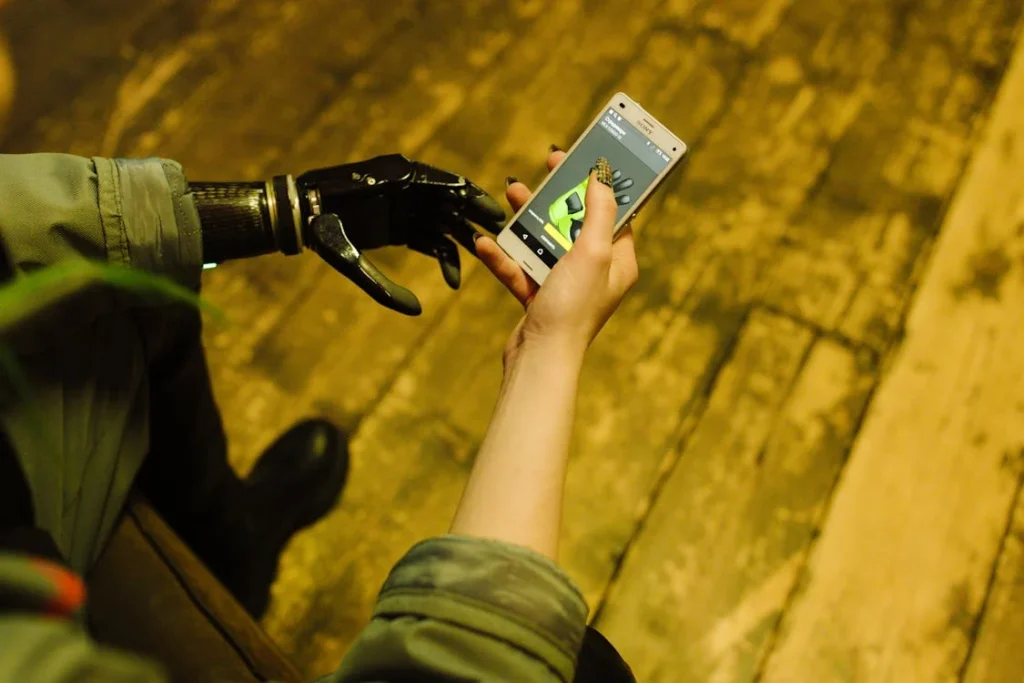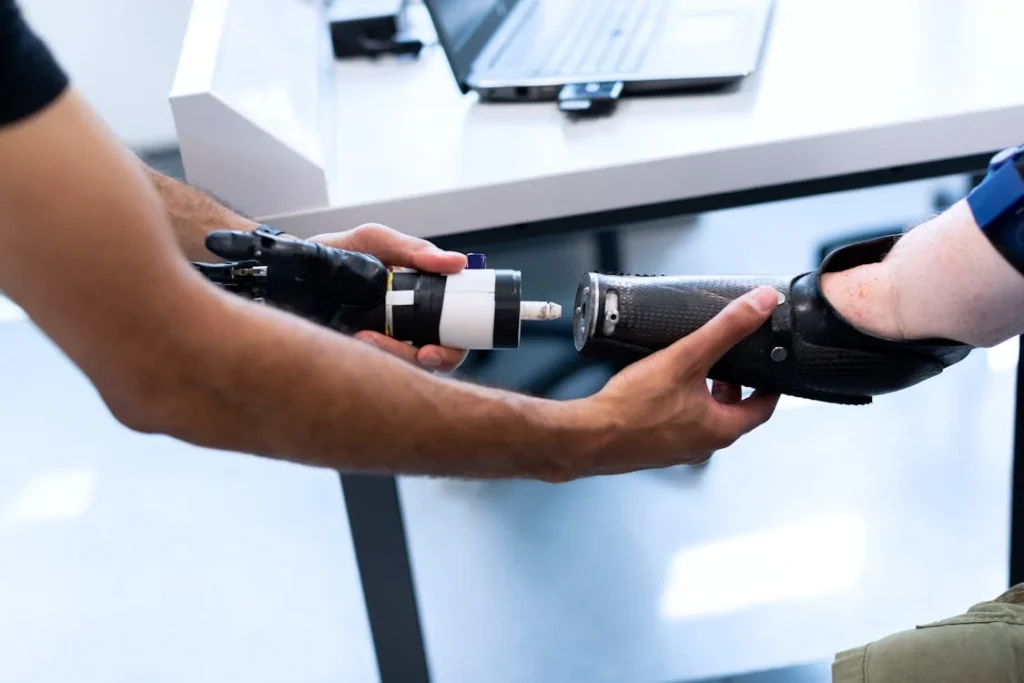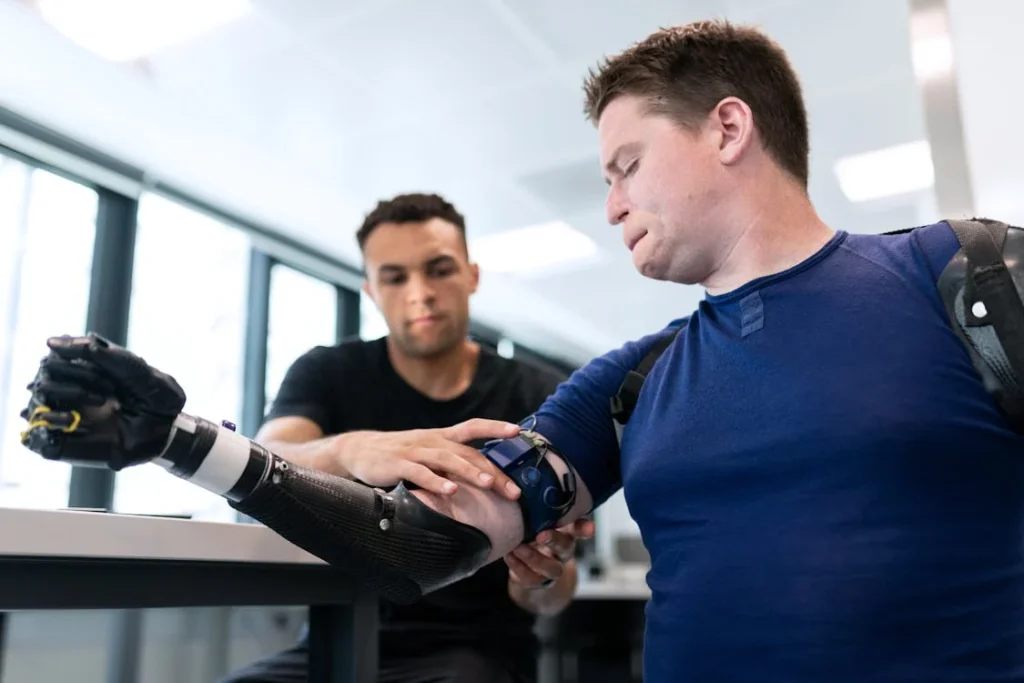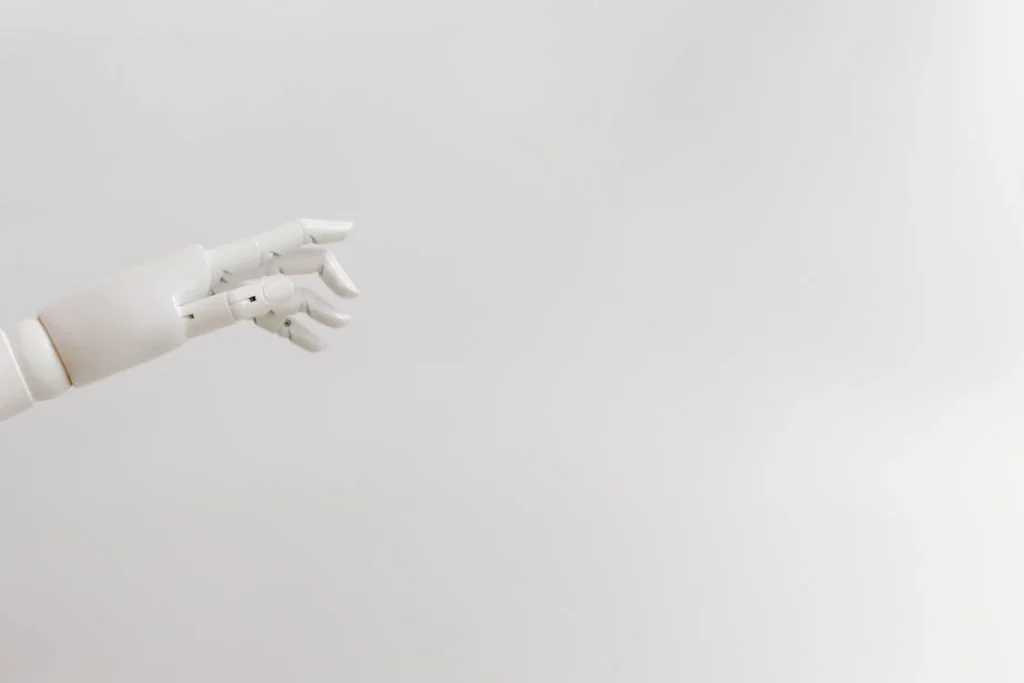The loss of a limb is more than just a physical challenge—it’s an emotional and psychological journey. While modern prosthetics have come a long way in restoring mobility, one essential element has always been missing: the sense of touch. Without it, even the most advanced prosthetic hand feels like a tool rather than a part of the body. But what if bionic prosthetics could bring back the ability to feel?
Recent innovations in sensory feedback are making this idea a reality. Scientists, engineers, and prosthetic manufacturers like Robobionics are working on solutions that allow users to experience sensations—pressure, texture, and even temperature—through their prosthetic limbs. This breakthrough isn’t just about making life more convenient; it’s about making prosthetic limbs truly belong to the people who use them.

Understanding Sensory Feedback in Bionic Prosthetics
For years, prosthetic limbs have focused on function—gripping, walking, and performing basic tasks.
But something crucial has been missing: the ability to feel. Without touch, even the most advanced bionic limbs feel detached, like a tool rather than a natural extension of the body.
Sensory feedback aims to change that by making prosthetic limbs more responsive and intuitive.
How the Human Body Experiences Touch
To understand how bionic prosthetics can restore touch, it helps to know how our bodies naturally process sensory information.
The skin is packed with tiny sensors called mechanoreceptors. These receptors detect pressure, texture, and temperature, then send signals to the brain through the nervous system.
This system allows us to feel the difference between rough and smooth surfaces, sense how much force we need to grip an object, and even react to pain.
When someone loses a limb, they don’t just lose mobility; they also lose this crucial sensory connection.
Traditional prosthetics cannot send signals to the brain, so users must rely on sight and experience to judge how much force to use when gripping something. This can make simple tasks frustrating and sometimes even impossible.
The Science Behind Sensory Feedback in Prosthetics
Sensory feedback in bionic prosthetics works by recreating the lost connection between the limb and the brain. There are several ways this can be achieved:
- Electrical Stimulation – Electrodes are placed on the remaining nerves in the amputated limb. These electrodes send tiny electrical pulses that mimic natural nerve signals, tricking the brain into perceiving touch.
- Vibration Sensors – Small vibration motors inside the prosthetic hand or foot create a subtle buzzing sensation whenever the limb touches something. This gives users a sense of contact and pressure.
- Pressure Sensors – These sensors detect how much force is being applied and send signals to a device that translates it into a feeling the brain can recognize.
- Temperature Feedback – Some research explores the use of thermoelectric devices that allow users to perceive temperature changes through their prosthetic limbs.
The Role of Brain Integration
One of the most exciting areas of development is the direct connection between bionic limbs and the brain.
Researchers are exploring brain-machine interfaces (BMIs), where signals from the brain control the prosthetic and receive feedback in return.
This two-way communication means that when a person touches an object with their prosthetic hand, their brain receives real sensory data rather than just a visual confirmation.
This kind of integration could make bionic limbs feel truly natural. Users wouldn’t have to concentrate on every movement or worry about applying too much or too little pressure.
Instead, their brain would instinctively know how to interact with objects, just like with a real hand.
Challenges in Restoring Touch
While these advancements are promising, restoring touch through prosthetics isn’t easy.
One major challenge is ensuring that the sensory signals feel natural. If the feedback is too weak, it may not be useful.
If it’s too strong or unnatural, it could cause discomfort or confusion. Scientists must also make sure that these systems are reliable, safe, and comfortable for long-term use.
Cost is another barrier. High-tech sensory feedback prosthetics are expensive, and accessibility is a concern.
This is why companies like Robobionics are working on affordable and effective solutions to bring these innovations to more people.

Cutting-Edge Innovations in Sensory Feedback Technology
The dream of making prosthetic limbs feel natural is becoming a reality, thanks to groundbreaking research and technological advancements.
Scientists and engineers are developing new methods to bring back the sense of touch, allowing users to feel textures, pressure, and even pain.
These innovations are not just about improving functionality; they are about making prosthetics a true part of the user’s body.
Smart Materials and Advanced Sensors
A major breakthrough in sensory feedback comes from the development of smart materials and ultra-sensitive sensors. These materials can mimic the properties of human skin, detecting subtle differences in texture, pressure, and temperature.
One of the most promising technologies in this area is electronic skin, or e-skin. This flexible, lightweight material is embedded with thousands of tiny sensors that respond to touch.
When placed over a prosthetic hand, e-skin allows users to feel objects with a level of detail never before possible. Some e-skins can even repair themselves if damaged, making them more durable and cost-effective.
Another innovation is the use of piezoelectric sensors. These sensors generate small electrical signals when they are pressed or stretched, mimicking the way human skin reacts to touch.
When integrated into prosthetic limbs, they can send feedback to the nervous system, helping users gauge how much force they are applying when gripping objects.
Neural Implants and Direct Brain Communication
One of the most exciting areas of research in sensory feedback is the use of neural implants. These tiny devices are placed inside the nervous system and act as a bridge between the brain and the prosthetic limb.
By stimulating the nerves with electrical signals, these implants can create realistic sensations of touch.
In some experiments, users with neural implants have reported feeling the softness of a pillow, the roughness of a rock, and even the gentle pressure of a handshake.
This level of detail is a game-changer for prosthetic technology, making everyday interactions feel natural and intuitive.
Another approach is brain-machine interfaces (BMIs), which allow direct communication between the brain and the prosthetic limb.
With this technology, users can not only control their prosthetics with their thoughts but also receive sensory information in real-time.
This means they can adjust their grip strength instinctively, without having to look at what they’re doing.
Haptic Feedback Systems
Haptic feedback is another major step forward in restoring touch through bionic prosthetics. This technology uses vibrations or electrical pulses to simulate the sensation of touch.
When a prosthetic hand grips an object, sensors detect the pressure and send a signal to a small motor that vibrates against the user’s skin.
The stronger the grip, the more intense the vibration, allowing users to sense how much force they are using.
Some advanced haptic systems use electro-tactile stimulation, where small electrical currents are applied to the skin to create a tingling or pressure-like sensation.
This method is particularly effective for users with high-level amputations, as it can be applied to different areas of the body to create a realistic sense of touch.
The Role of AI and Machine Learning
Artificial intelligence and machine learning are playing a key role in improving sensory feedback technology.
By analyzing patterns in how users interact with objects, AI can fine-tune the signals sent to the brain, making the sensation of touch feel more natural.
AI can also help prosthetic limbs adapt to different situations. For example, if a user is picking up a delicate object like an egg, the system can automatically adjust grip strength based on past experiences.
This makes prosthetic limbs smarter and easier to use, reducing the mental effort required for everyday tasks.
Bringing Sensory Feedback to More People
While these innovations are exciting, accessibility remains a major challenge.
Many high-tech prosthetic limbs are expensive and require specialized medical care to install and maintain.
At Robobionics, we are focused on creating cost-effective solutions that make these advancements available to more people.
One approach is developing modular sensory feedback systems that can be added to existing prosthetic limbs.
Instead of requiring a completely new device, users can upgrade their prosthetics with sensory-enhancing features as technology improves.
This makes advanced prosthetic technology more affordable and practical for a wider range of users.

The Real-World Impact of Sensory Feedback in Bionic Prosthetics
Technological advancements in prosthetic limbs are impressive, but the real measure of success is how they change lives.
Sensory feedback is more than just an upgrade—it is a transformation that allows users to interact with the world in a way that feels natural and intuitive.
From simple everyday tasks to emotional moments like holding a loved one’s hand, the ability to feel again has a profound impact.
Restoring Independence in Daily Life
For prosthetic users, everyday activities that most people take for granted can be challenging. Tasks like buttoning a shirt, holding a fragile glass, or typing on a keyboard require precise pressure control and dexterity.
Without sensory feedback, users must rely on visual cues, often leading to frustration and mistakes. With sensory-enhanced prosthetics, users no longer need to guess how much force to apply.
If a prosthetic hand can send signals about grip strength, a user can instinctively adjust without having to think about it. This allows for smoother, more natural movements and makes daily activities easier.
For example, a person using a bionic hand with touch sensors can pick up a ripe fruit without crushing it. A prosthetic leg with pressure sensors can provide better balance, making walking more stable and less exhausting.
These small improvements add up to greater independence and confidence in everyday life.
Emotional and Psychological Benefits
Losing a limb is not just a physical loss; it also has a deep emotional impact.
Many amputees struggle with feeling disconnected from their prosthetic limbs, making them hesitant to fully embrace them as part of their bodies.
Sensory feedback helps bridge this gap by making prosthetic limbs feel more like real extensions of the body.
Touch plays a huge role in human connection. A handshake, a pat on the back, or the warmth of a loved one’s hand can carry deep emotional meaning.
For amputees, the inability to feel these interactions can lead to a sense of loss. With advanced sensory feedback, these moments become possible again.
Users of touch-enabled prosthetics report feeling more engaged in social interactions and more connected to the world around them.
Psychologically, having a prosthetic limb that provides feedback also reduces phantom limb pain, a condition where amputees feel sensations in their missing limb.
By giving the brain real sensory input, the confusion that causes phantom pain can be reduced, leading to better overall well-being.
Enhancing Performance for Specialized Activities
Sensory feedback is also changing the way prosthetic users engage in specialized activities.
Athletes, musicians, and skilled workers require precision and control in their movements—something traditional prosthetics struggle to provide.
A runner using a bionic leg with sensory feedback can feel the ground beneath them, adjusting their stride in real-time to improve stability and performance.
A musician with a prosthetic hand can sense the pressure needed to play an instrument with more accuracy. A craftsman can handle delicate tools without fear of applying too much force.
These innovations are not just about restoring normal function; they are about pushing boundaries.
By making bionic limbs smarter and more responsive, users can explore new opportunities and careers that were once considered impossible after amputation.
Making Sensory Feedback Accessible to More People
Despite the incredible advancements in sensory feedback technology, accessibility remains a challenge.
High-end prosthetic limbs with advanced touch capabilities are expensive, putting them out of reach for many people who need them.
This is where companies like Robobionics are making a difference. By focusing on cost-effective solutions, modular upgrades, and innovative manufacturing techniques,
Robobionics is working to make sensory feedback technology more affordable and widely available. We believe that every prosthetic user deserves the ability to feel and interact with the world in a natural way.

The Future of Sensory Feedback in Bionic Prosthetics
Sensory feedback technology in prosthetics is advancing at an incredible pace, but there is still a long way to go before these innovations become a standard part of everyday prosthetic solutions.
Scientists, engineers, and prosthetic manufacturers are continuously exploring new ways to enhance touch perception, improve affordability, and make bionic limbs feel as natural as possible.
The future of bionic prosthetics is filled with exciting possibilities, from artificial skin that closely mimics human sensation to brain-controlled limbs that respond instantly to thought.
Advancements in Artificial Skin Technology
One of the biggest breakthroughs on the horizon is the development of artificial skin that closely replicates human skin.
This involves materials that not only detect pressure and texture but also stretch and move like real skin.
The goal is to create a prosthetic covering that feels lifelike to the touch while also providing real-time sensory input to the user.
Some researchers are working on bioengineered skin made from lab-grown cells that can integrate with electronic sensors.
This hybrid approach could allow for a more seamless connection between bionic limbs and the human nervous system.
Other teams are focusing on flexible nanomaterials that can detect subtle changes in pressure and temperature, mimicking the sensitivity of fingertips.
If successful, artificial skin could take bionic prosthetics to a whole new level.
Instead of simply receiving basic pressure feedback, users could experience a full range of sensations, including the difference between rough and smooth surfaces, or even the warmth of another person’s hand.
Brain-Integrated Prosthetics for Instant Response
Another exciting development is the use of brain-machine interfaces (BMIs) to make prosthetics feel more natural and responsive.
Current prosthetics rely on sensors placed on the remaining muscles of an amputated limb, but BMIs go a step further by allowing direct communication between the brain and the prosthetic.
With this technology, a prosthetic user could think about moving their artificial hand, and it would respond instantly—just like a real limb. More importantly, sensory data could travel back to the brain, creating a true two-way connection.
This could eliminate the need for external controls or manual adjustments, making prosthetic limbs feel completely integrated into the user’s body.
Although BMIs are still in the experimental stage, early tests have been promising. Some amputees have successfully used brain-controlled prosthetics to pick up delicate objects, type on keyboards, and even play musical instruments.
As research progresses, these systems could become more compact, affordable, and practical for everyday use.
Wireless and Energy-Efficient Systems
One of the biggest challenges in advanced prosthetic technology is power consumption. Many high-tech prosthetics require external batteries or frequent recharging, which can be inconvenient for users.
The future of bionic limbs will likely focus on energy-efficient systems that last longer and operate wirelessly.
Scientists are exploring self-powered prosthetics that generate energy from body movements, similar to how smartwatches can charge using motion.
There is also research into wireless energy transfer, which would allow prosthetic limbs to receive power without the need for bulky batteries or cables.
In addition, advances in miniaturization are making it possible to create ultra-small sensors and processors that can fit inside a prosthetic limb without adding extra weight.
These improvements will help make bionic limbs more practical, comfortable, and efficient for everyday users.
Making Sensory Feedback Available to Everyone
While the future of sensory feedback in prosthetics is exciting, the real challenge lies in making these technologies available to as many people as possible.
High-end bionic limbs with advanced sensory features often cost thousands of dollars, making them inaccessible to many who need them.
At Robobionics, we are committed to finding practical solutions that bring the benefits of sensory feedback to more users. By developing modular systems, users can upgrade their existing prosthetics without having to buy an entirely new limb.
We also focus on cost-effective manufacturing techniques, such as 3D printing, to reduce costs while maintaining high-quality standards.
Collaboration between researchers, healthcare providers, and prosthetic manufacturers will be key in ensuring that future advancements are not just limited to a select few but are accessible to people of all income levels.
The goal is to make sensory-enhanced prosthetics a standard part of rehabilitation and recovery, improving the lives of millions around the world.
The future is bright for bionic prosthetics. With continued innovation, the dream of restoring touch to artificial limbs is closer than ever.
As technology advances and accessibility improves, more and more people will experience the freedom and confidence that comes with having a prosthetic limb that truly feels like part of them.

The Role of Rehabilitation in Adapting to Sensory-Enabled Prosthetics
Technological advancements in sensory feedback are changing the way prosthetic users interact with the world, but technology alone is not enough.
Adapting to a prosthetic limb—especially one with advanced touch capabilities—requires training, rehabilitation, and mental adjustment.
Even the most sophisticated bionic hand will not feel natural on the first day. Just like learning to walk or write with the non-dominant hand, the brain and body must adapt over time.
Rehabilitation plays a critical role in helping users get the most out of their sensory-enhanced prosthetics.
It is not just about learning how to operate the limb but also about retraining the brain to process the new sensory input.
Without proper rehabilitation, even the most advanced prosthetic might feel unnatural, frustrating, or overwhelming.
Retraining the Brain to Process Sensory Feedback
When someone loses a limb, their brain gradually stops expecting sensory input from that part of the body. Over time, the neural pathways that once processed touch signals from the missing limb weaken.
When a sensory-enabled prosthetic is introduced, the brain must reawaken those pathways and learn to interpret artificial signals as real sensations.
This process is similar to how the brain adjusts to a cochlear implant for hearing loss.
At first, the sounds may seem strange and mechanical, but with consistent exposure and practice, the brain learns to make sense of them.
In prosthetic rehabilitation, therapists use structured exercises to help users recognize and interpret different types of sensory feedback.
For example, a user might start by distinguishing between different levels of pressure applied to the prosthetic hand.
Over time, they can progress to identifying textures, shapes, and even temperature differences.
Virtual reality (VR) and gamified training programs are also being developed to make this learning process more engaging and effective.
The Importance of Muscle Memory and Coordination
Even with sensory feedback, using a prosthetic limb is not entirely instinctive. Just as a person without a prosthetic refines their coordination over years of experience, prosthetic users must develop their own muscle memory.
This requires targeted exercises that focus on grip strength, control, and reflexes. One of the biggest challenges is learning how to apply just the right amount of force when gripping objects.
With traditional prosthetics, users often rely on sight and trial-and-error to prevent dropping or crushing objects.
Sensory feedback removes some of this guesswork, but it takes time for the brain and body to fully integrate these signals into daily movements.
Occupational therapists work with users to practice real-life tasks, such as picking up a cup, turning a doorknob, or holding a pen.
Over time, these movements become more fluid and natural, allowing users to perform daily activities without having to consciously think about every action.
Psychological and Emotional Support in the Adaptation Process
The transition to a sensory-enhanced prosthetic is not just physical—it is deeply emotional as well.
Many amputees go through a range of feelings, from excitement about new possibilities to frustration when things do not work as expected.
This is why psychological support is just as important as physical training.
Some users may feel overwhelmed by the new sensory input, especially if they have lived without sensation in the missing limb for many years.
Others may struggle with confidence, fearing that their prosthetic will not function as expected in social or work situations.
Having access to counseling, peer support groups, and mental health professionals can make a huge difference in helping users adjust.
Another major factor is the reduction of phantom limb pain. Many amputees experience lingering sensations from their missing limb, sometimes in the form of pain or discomfort.
Studies show that sensory feedback in prosthetics can help reduce phantom limb pain by providing the brain with real input, decreasing the confusion that causes these sensations.
The Future of Rehabilitation for Sensory Prosthetics
As sensory feedback technology improves, rehabilitation methods must evolve as well. Future prosthetic training may incorporate artificial intelligence (AI) to customize exercises based on the user’s progress.
VR environments could provide immersive practice scenarios, allowing users to interact with virtual objects before using their prosthetic in real-world situations.
At Robobionics, we recognize that rehabilitation is just as important as the technology itself.
That is why we emphasize home-based gamified training programs, ensuring that users can practice their prosthetic skills in a comfortable and engaging way.
Our approach helps users adapt faster and more effectively, making their prosthetic limb feel like a natural part of their body.

The Intersection of Prosthetics and Artificial Intelligence
Artificial intelligence is transforming many industries, and prosthetics is no exception. AI is playing a crucial role in improving sensory feedback, movement control, and overall user experience.
The combination of AI and bionic prosthetics is creating smarter, more adaptive limbs that respond to the user’s needs in real-time.
Instead of relying solely on manual adjustments or pre-programmed responses, AI-driven prosthetics learn from the user’s habits and refine their functionality over time.
How AI Enhances Sensory Feedback
One of the biggest challenges in sensory-enabled prosthetics is making the feedback feel natural. AI helps solve this problem by processing vast amounts of data from sensors embedded in the prosthetic limb.
These sensors detect pressure, texture, temperature, and movement, but raw data alone is not enough. AI translates these signals into meaningful sensations that the brain can understand.
For example, when a user grips a soft object like a piece of fruit, AI can adjust the pressure feedback to ensure they do not squeeze too hard.
If the prosthetic hand detects a slippery surface, AI can automatically increase grip strength to prevent the object from slipping.
These intelligent adjustments make movements more fluid and intuitive, reducing the learning curve for users adapting to a bionic limb. Machine learning also plays a role in refining sensory feedback over time.
The more a user interacts with different objects, the better AI becomes at predicting the level of force, grip, and touch sensitivity needed for each task.
This allows prosthetic limbs to feel more responsive and natural the longer they are used.
AI-Powered Motion Control and Adaptability
Beyond sensory feedback, AI is revolutionizing how prosthetic limbs move. Traditional prosthetics rely on simple mechanical controls or pre-set motion patterns, but AI-driven limbs can adapt in real-time.
One of the most exciting developments is predictive movement control, where AI anticipates the user’s next action based on past behavior and current muscle signals.
If a user frequently reaches for a cup with a specific grip, AI can detect the motion early and prepare the prosthetic hand to form the correct shape automatically.
This reduces the mental effort needed to operate the limb, making movements feel more seamless.
AI also improves adaptability across different environments. Walking on flat ground requires different muscle engagement than walking on uneven terrain.
AI-powered prosthetic legs analyze real-time data from pressure sensors and accelerometers to adjust accordingly. This means users can walk with greater stability, reducing the risk of falls and discomfort.
AI and Brain-Computer Interfaces
The future of prosthetic control lies in brain-computer interfaces (BCIs), which use AI to interpret brain signals and translate them into precise movements.
Instead of relying on muscle contractions or external controls, users can simply think about moving their prosthetic limb, and it will respond instantly.
AI enhances this process by filtering out background noise from brain activity and focusing only on relevant movement signals.
This makes BCIs more reliable and practical for everyday use. Some research labs have already developed brain-controlled prosthetics that allow users to pick up objects, play musical instruments, and even perform fine motor tasks with remarkable accuracy.
As AI technology improves, brain-controlled prosthetics will become more accessible, removing the need for extensive training or calibration.
The goal is to create a completely intuitive experience, where using a prosthetic limb feels no different from using a natural one.
AI’s Role in Prosthetic Maintenance and Customization
AI is not just helping users operate prosthetic limbs—it is also improving maintenance and customization.
Many modern prosthetics come with self-monitoring systems that detect mechanical issues and predict when repairs or adjustments are needed.
AI-driven diagnostics can identify problems early, reducing the likelihood of sudden failures or malfunctions.
Customization is another area where AI is making a difference. Instead of a one-size-fits-all approach, AI analyzes a user’s movement patterns, daily activities, and sensory preferences to fine-tune the prosthetic limb.
This ensures that each user gets a personalized experience tailored to their unique needs.
At Robobionics, we recognize the potential of AI in making prosthetics smarter, more user-friendly, and more accessible.
By integrating AI-driven features into our designs, we aim to provide prosthetic users with cutting-edge solutions that continuously evolve to improve their quality of life.
Conclusion
The advancements in sensory feedback and artificial intelligence are transforming bionic prosthetics from simple mechanical tools into highly intuitive, lifelike extensions of the human body. With innovations in neural implants, AI-driven adaptability, and artificial skin, prosthetic users can now regain not only function but also the sense of touch—something once thought impossible.
These breakthroughs are not just about technology; they are about restoring confidence, independence, and emotional connection. From improving daily tasks to enhancing specialized skills, sensory-enabled prosthetics are redefining what it means to live with a limb difference.
However, accessibility remains a key challenge. At Robobionics, we are committed to making these innovations available to more people by developing cost-effective solutions and practical rehabilitation programs. Sensory feedback is not just the future—it is becoming a reality, bringing us closer to a world where bionic limbs feel as natural as the ones they replace.
The journey is far from over, but every step forward brings new hope. With continuous research and collaboration, we are moving toward a future where prosthetic users can fully experience the world through touch once again.



